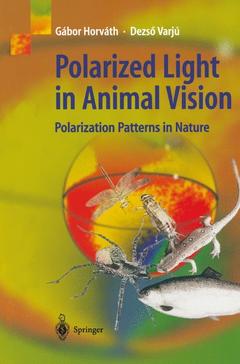Polarized Light in Animal Vision, Softcover reprint of hardcover 1st ed. 2004 Polarization Patterns in Nature
Langue : Français
Auteurs : Horváth Gábor, Varju Dezsö

The subject of this volume is two-fold. First, it gathers typical polarization patterns occurring in nature. Second, it surveys the polarization-sensitive ani mals, the physiological mechanisms and biological functions of polarization sensitivity as weIl as the polarization-guided behaviour in animals. The monograph is prepared for biologists, physicists and meteorologists, espe cially for experts of atmospheric optics and animal vision, who wish to under stand and reveal the message hidden in polarization patterns of the optical environment not directly accessible to the human visual system, but measur able by polarimetry and perceived by many animals. Our volume is an attempt to build a bridge between these two physical and biological flelds. In Part I we introduce the reader to the elements of imaging polarimetry. This technique can be efflciently used, e. g. in atmospheric optics, remote sens ing and biology. In Part 11 we deal with typical polarization patterns of the natural optical environment. Sunrise/sunset, clear skies, cloudy skies, moonshine and total solar eclipses all mean quite different illumination conditions, wh ich also affect the spatial distribution and strength of celestial polarization. We pre sent the polarization patterns of the sky and its unpolarized (neutral) points under sunlit, moonlit, clear, cloudy and eclipsed conditions as a function of solar elevation. The polarization pattern of a rainbow is also shown. That part of the spectrum is derived in which perception of skylight polarization is optimal under partly cloudy skies.
I: Imaging Polarimetry.- 1 Polarimetry: From Point-Source to Imaging Polarimeters.- II: Polarization Patterns in Nature.- 2 Space-Borne Measurement of Earthlight Polarization.- 3 Skylight Polarization.- 4 Principal Neutral Points of Atmospheric Polarization.- 5 24-Hour Change of the Polarization Pattern of the Summer Sky North of the Arctic Circle.- 6 Polarization Patterns of Cloudy Skies and Animal Orientation.- 7 Ground-Based Full-Sky Imaging Polarimetric Cloud Detection.- 8 Polarization Pattern of the Moonlit Clear Night Sky at Full Moon: Comparison of Moonlit and Sunlit Skies.- 9 Imaging Polarimetry of the Rainbow.- 10 Which Part of the Spectrum is Optimal for Perception of Skylight Polarization?.- 11 Polarization of the Sky and the Solar Corona During Total Solar Eclipses.- 12 Reflection-Polarization Pattern of the Flat Water Surface Measured by 180° Field-of-View Imaging Polarimetry.- 13 Polarization Pattern of a Fata Morgana: Why Aquatic Insects are not Attracted by Mirages?.- 14 Polarizational Characteristics of the Underwater World.- 15 Circularly Polarized Light in Nature.- III: Polarized Light in Animal Vision.- 16 From Polarization Sensitivity to Polarization Vision.- 17 Polarization Sensitivity in Terrestrial Insects.- 18 Polarization Sensitivity in Insects Associated with Water.- 19 Multiple-Choice Experiments on Dragonfly Polarotaxis.- 20 How can Dragonflies Discern Bright and Dark Waters from a Distance? The Degree of Linear Polarization of Reflected Light as a Possible Cue for Dragonfly Habitat Selection.- 21 Oil Reservoirs and Plastic Sheets as Polarizing Insect Traps.- 22 Why do Mayflies Lay Eggs on Dry Asphalt Roads? Water-Imitating Horizontally Polarized Light Reflected from Asphalt Attracts Ephemeroptera.- 23 Reflection-PolarizationalCharacteristics of Car-Bodies: Why are Water-Seeking Insects Attracted to the Bodywork of Cars?.- 24 Polarization Sensitivity in Spiders and Scorpions.- 25 Polarization Sensitivity in Crustaceans.- 26 Polarization Sensitivity in Cephalopods and Marine Snails.- 27 Polarization-Sensitive Optomotor Reaction in Invertebrates.- 28 Polarization Sensitivity in Fish.- 29 Polarization Sensitivity in Amphibians.- 30 Polarization Sensitivity in Reptiles.- 31 Polarization Sensitivity in Birds.- 32 Human Polarization Sensitivity.- 33 Polarization-Induced False Colours.- 34 A Common Methodological Error: Intensity Patterns Induced by Selective Reflection of Linearly Polarized Light from Black Surfaces.- Rerences.- Colour Illustrations.
Comprehensive treatment of this fascinating phenomenon, treating the physical, meterological and physiological aspects adequately Illustrated with over hundred figures and additional 16 superb colour plates Includes vivid case studies of various species, from insects, birds or fishes The authors, both physicists, are well known experts, they received many awards and prizes for their biophysical work Includes supplementary material: sn.pub/extras
Date de parution : 11-2003
Ouvrage de 420 p.
23.5x15.9 cm
Thèmes de Polarized Light in Animal Vision :
© 2024 LAVOISIER S.A.S.
